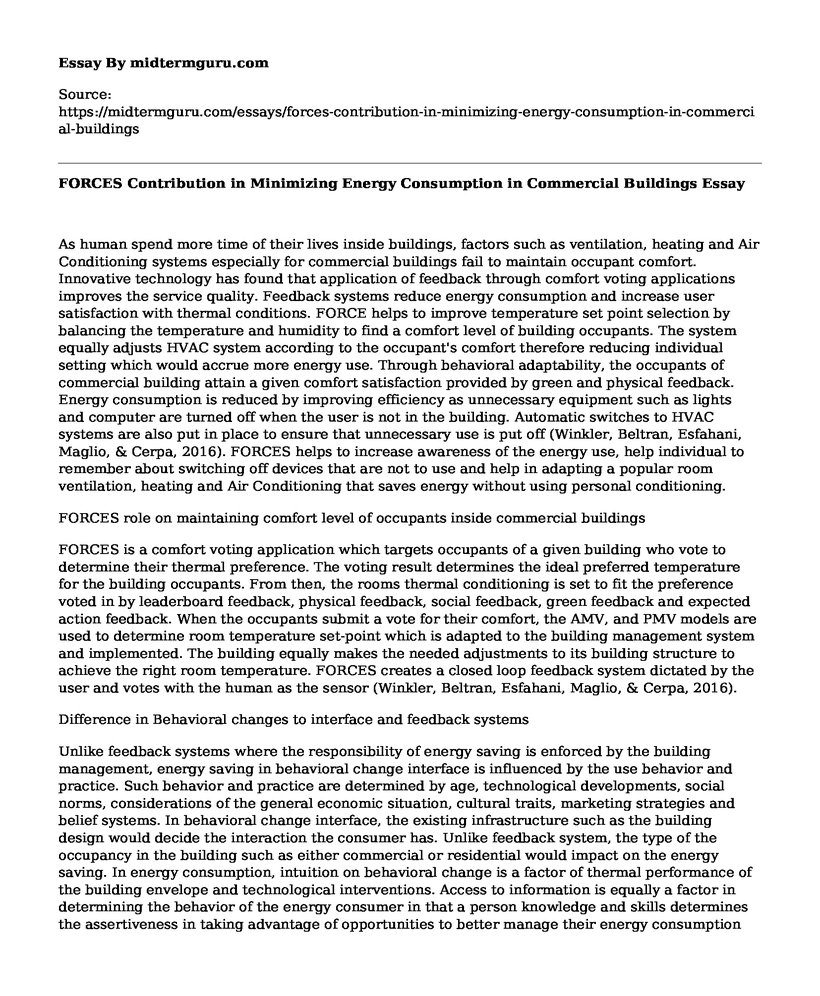As human spend more time of their lives inside buildings, factors such as ventilation, heating and Air Conditioning systems especially for commercial buildings fail to maintain occupant comfort. Innovative technology has found that application of feedback through comfort voting applications improves the service quality. Feedback systems reduce energy consumption and increase user satisfaction with thermal conditions. FORCE helps to improve temperature set point selection by balancing the temperature and humidity to find a comfort level of building occupants. The system equally adjusts HVAC system according to the occupant's comfort therefore reducing individual setting which would accrue more energy use. Through behavioral adaptability, the occupants of commercial building attain a given comfort satisfaction provided by green and physical feedback. Energy consumption is reduced by improving efficiency as unnecessary equipment such as lights and computer are turned off when the user is not in the building. Automatic switches to HVAC systems are also put in place to ensure that unnecessary use is put off (Winkler, Beltran, Esfahani, Maglio, & Cerpa, 2016). FORCES helps to increase awareness of the energy use, help individual to remember about switching off devices that are not to use and help in adapting a popular room ventilation, heating and Air Conditioning that saves energy without using personal conditioning.
FORCES role on maintaining comfort level of occupants inside commercial buildings
FORCES is a comfort voting application which targets occupants of a given building who vote to determine their thermal preference. The voting result determines the ideal preferred temperature for the building occupants. From then, the rooms thermal conditioning is set to fit the preference voted in by leaderboard feedback, physical feedback, social feedback, green feedback and expected action feedback. When the occupants submit a vote for their comfort, the AMV, and PMV models are used to determine room temperature set-point which is adapted to the building management system and implemented. The building equally makes the needed adjustments to its building structure to achieve the right room temperature. FORCES creates a closed loop feedback system dictated by the user and votes with the human as the sensor (Winkler, Beltran, Esfahani, Maglio, & Cerpa, 2016).
Difference in Behavioral changes to interface and feedback systems
Unlike feedback systems where the responsibility of energy saving is enforced by the building management, energy saving in behavioral change interface is influenced by the use behavior and practice. Such behavior and practice are determined by age, technological developments, social norms, considerations of the general economic situation, cultural traits, marketing strategies and belief systems. In behavioral change interface, the existing infrastructure such as the building design would decide the interaction the consumer has. Unlike feedback system, the type of the occupancy in the building such as either commercial or residential would impact on the energy saving. In energy consumption, intuition on behavioral change is a factor of thermal performance of the building envelope and technological interventions. Access to information is equally a factor in determining the behavior of the energy consumer in that a person knowledge and skills determines the assertiveness in taking advantage of opportunities to better manage their energy consumption (Yan, OBrien, Hong, Feng, Gunay, Tahmasebi & Mahdavi, 2015). To change the consumer behavior and practices, there is need to implement smart steps that would guarantee full implementation of energy efficient policies. Unlike in feedback systems where the system is controlled automatically or by another person, in Behavioral changes interface the consumer controls the system, and high consumer discipline is needed in such situation. In addition, the feedback system is more effective in energy saving than behavioral changes interface.
References
Winkler, D. A., Beltran, A., Esfahani, N. P., Maglio, P. P., & Cerpa, A. E. (2016, September). FORCES: feedback and control for occupants to refine comfort and energy savings. In Proceedings of the 2016 ACM International Joint Conference on Pervasive and Ubiquitous Computing (pp. 1188-1199). ACM.Yan, D., OBrien, W., Hong, T., Feng, X., Gunay, H. B., Tahmasebi, F., & Mahdavi, A. (2015). Occupant behavior modeling for building performance simulation: Current state and future challenges. Energy and Buildings, 107, 264-278.
Cite this page
FORCES Contribution in Minimizing Energy Consumption in Commercial Buildings. (2021, May 25). Retrieved from https://midtermguru.com/essays/forces-contribution-in-minimizing-energy-consumption-in-commercial-buildings
If you are the original author of this essay and no longer wish to have it published on the midtermguru.com website, please click below to request its removal:
- Research Paper on Use of Surveillance Drones for Virtual City
- Passive and Active Hybrid Approach to Building Design in Saudi Arabia - Essay Sample
- Japan's Nuclear Disaster: Worries of Long-term Radiation Effects - Essay Sample
- Digital Privacy: Securing Your Data in the Age of Mobile Devices - Essay Sample
- Get a Good Deal on Car Insurance in Florida - Essay Sample
- Open Innovation: Unlocking Economic & Social Change in Africa - Essay Sample
- 40% Global Energy Use: Impact of Building, Construction Industry - Essay Sample







